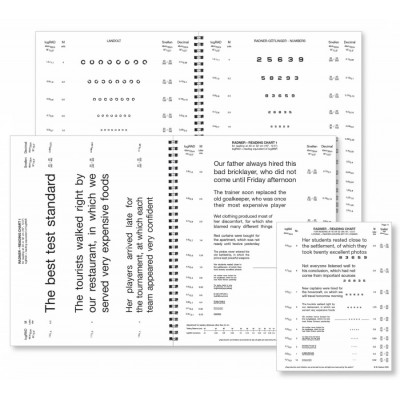- 50% SALE
- Anatomy of the Eye
- Domiciliary
- Illuminated Cabinets
- Low Vision Aids
- New Products
- Charts & Distance Tests
- COVID
- Clinical Trials Products
- Dispensing & Workshop
- Field Screening
- General Refraction
- Amsler Chart
- Autorefractors & Keratometers
- Bagolini Striated Lenses
- Cardiff Cards
- Clip-on Occluder
- Colour Tests
- Cross Cylinders
- Domiciliary
- Filter Bars
- Fixation Sticks
- Halberg Clips
- Lens Confirmation Tests
- Maddox Phoria Measure
- Maddox Wing Test
- Near Vision
- Occluders
- Optician Starter Kit
- Optokinetic Drum
- Paddle Retinoscopy Rack Set
- Pen Torch
- Polarising Visor
- Prisms & Prism Bars
- Refracto-Rack
- Stereo Tests
- Trial Frames
- Trial Lens Sets
- Trial Lens Spares
- Volk & Ocular Lenses
- Furniture
- Scopes & Loupes
- Sports Vision
Radner Reading Chart
The Radner reading chart is a highly standardized multilingual reading test system that was recently developed for clinical practice and research. During the past few years, it has become an international project; together with several universities developed an international and interdisciplinary cooperation with psychologists, linguists, statisticians and ophthalmologists. The result of the collaboration is a standardized, valid and reliable reading test system, available in numerous languages.
The reading chart consists of sentence optotypes, which are optimized reading test items, standardized by construction and statistical selection. Sentence optotypes consists of short sentences that are highly comparable in terms of number of words (14 words), word length, position of words, lexical difficulty and syntactical complexity. Language specific characteristics were taken into account as were the number of letters and syllables per word, line, and sentence.
A larger series of such sentences were then tested in different groups of probands (n=200) and the specific sentence optotypes for the reading charts were selected based on reading length, reading errors, reliability and statistical validity analyses.
The advantage of such sentence optotypes is that they minimize variations between test items and keep the geometric proportions constant. Changes in reading performance with smaller print sizes are therefore related to the print size and not to text characteristics. Together with a logarithmic scaling of the print sizes, it enables accurate and comparable measurements of reading acuity and/or reading speed at different acuity levels, independently of viewing distance.
Standardization was done in cooperation with the Institute of Medical Statistics, University of Vienna (led by Professor Bauer) using a test-retest reliability, inter-chart reliability and a variance component analysis in patient groups of various levels of visual acuity. The results showed an excellent reproducibility, validity, test reliability and inter-chart reliability.
Calculations are based on real word counts and, in addition, it has been shown that the reading speed measurements obtained with sentence optotypes correlate well (r>0.9) with that of standardized long text paragraphs.






